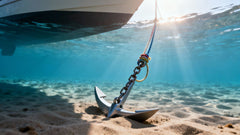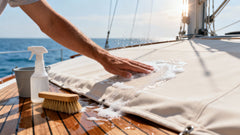Choosing Your Boat Anchor Chain
Your boat anchor chain is the unsung hero of your entire anchoring system. It’s far more than just a heavy link to the seabed; it's the critical connection that keeps your vessel secure when wind and waves start to kick up.
The chain's weight is its secret weapon, creating a gentle sag that absorbs shocks and ensures your anchor holds firm, keeping you right where you want to be.
The Unseen Hero of Your Anchoring System
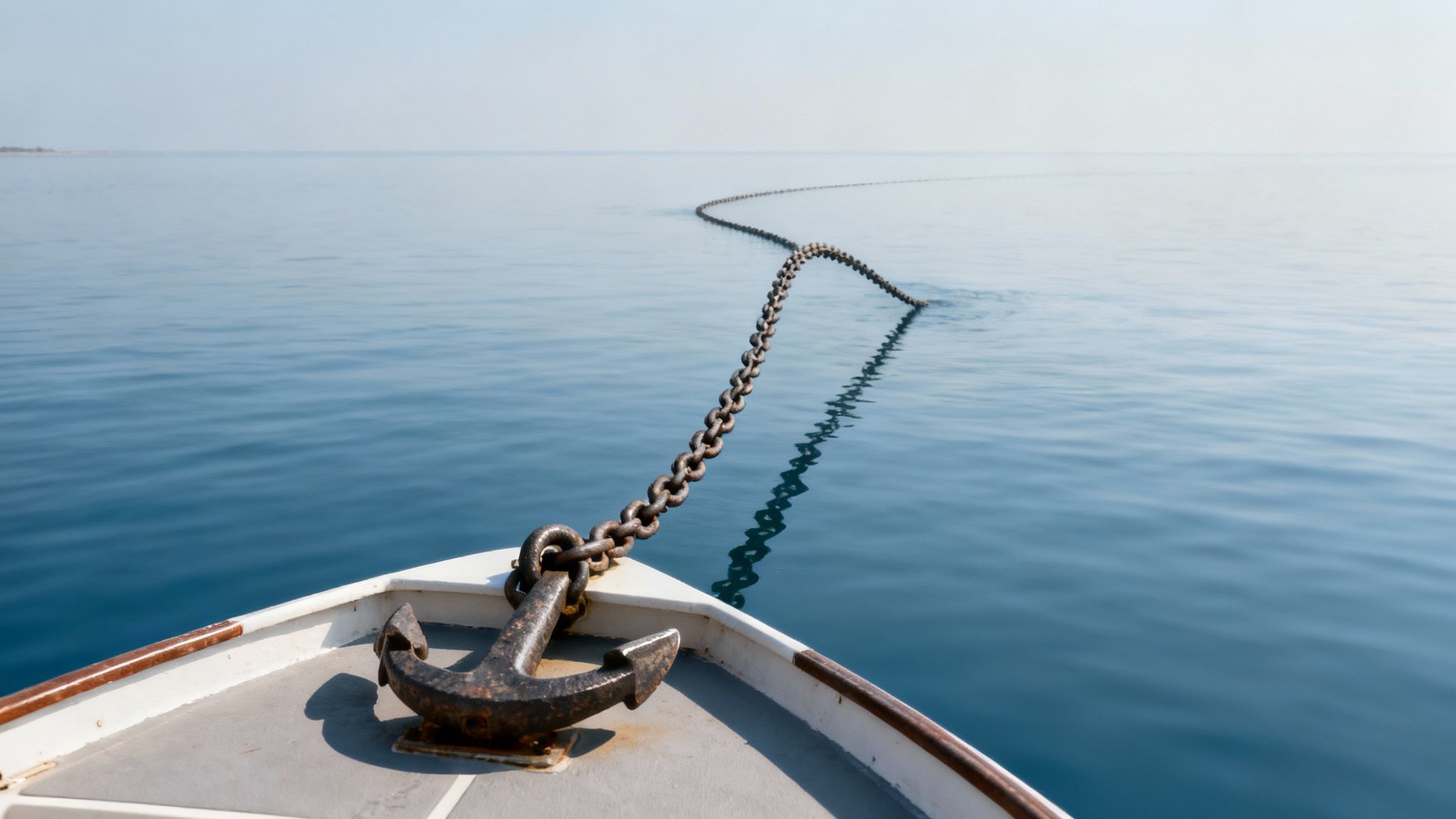
Picture your anchor chain as a purpose-built shock absorber. When a gust of wind or a rolling wave hits your boat, the force doesn't yank vertically on your anchor. Instead, all that energy is spent trying to lift the heavy, sagging section of the chain off the bottom.
This crucial sag is known as the catenary curve, and it’s the key to a secure hold. It keeps the pull on the anchor horizontal, allowing it to dig in deeper rather than getting ripped out of the seabed. Without that curve, every swell would jerk the boat and threaten to break your anchor free.
More Than Just Dead Weight
While the catenary effect is the star of the show, your anchor chain brings a few other non-negotiable benefits to the table—advantages that a simple rope rode can't offer on its own.
- Abrasion Resistance: Chain is tough as nails. It can easily handle grinding against rocks, coral, or a rough bottom that would shred a rope line in minutes.
- Holding Power: The sheer weight of the chain adds a significant amount of holding power all on its own, working alongside the anchor to keep you put.
- System Compatibility: Your anchor chain has to be a perfect match for your windlass gypsy—that’s the notched wheel that grabs the links. Get it wrong, and you’re looking at jams, a damaged windlass, or a dangerous failure when you need it most.
It's no surprise that the market for this essential piece of gear is growing. Valued at USD 112.38 billion in 2023, the global ship anchor chain market is projected to more than double by 2032, highlighting just how critical secure anchoring is across all marine industries.
Your anchoring system is only as strong as its weakest link. Investing in the right chain isn't just about ticking a box; it's about giving yourself peace of mind when the weather takes a turn.
Setting the Foundation for Safety
At the end of the day, your chain is the foundation of your entire anchoring strategy. It has to work seamlessly with your anchor to provide the security and stability you depend on. To build a truly reliable setup, you need to understand how all the pieces fit together, starting with our guide on choosing the best boat anchors for different conditions.
Of course, a great anchoring system is just one part of the bigger picture. Things like choosing the right boat for your comfort also play a huge role in your overall safety and enjoyment on the water. By breaking down these core concepts, you can anchor with confidence, knowing you’ve got the right gear and the knowledge to use it.
Understanding Chain Grades and Materials
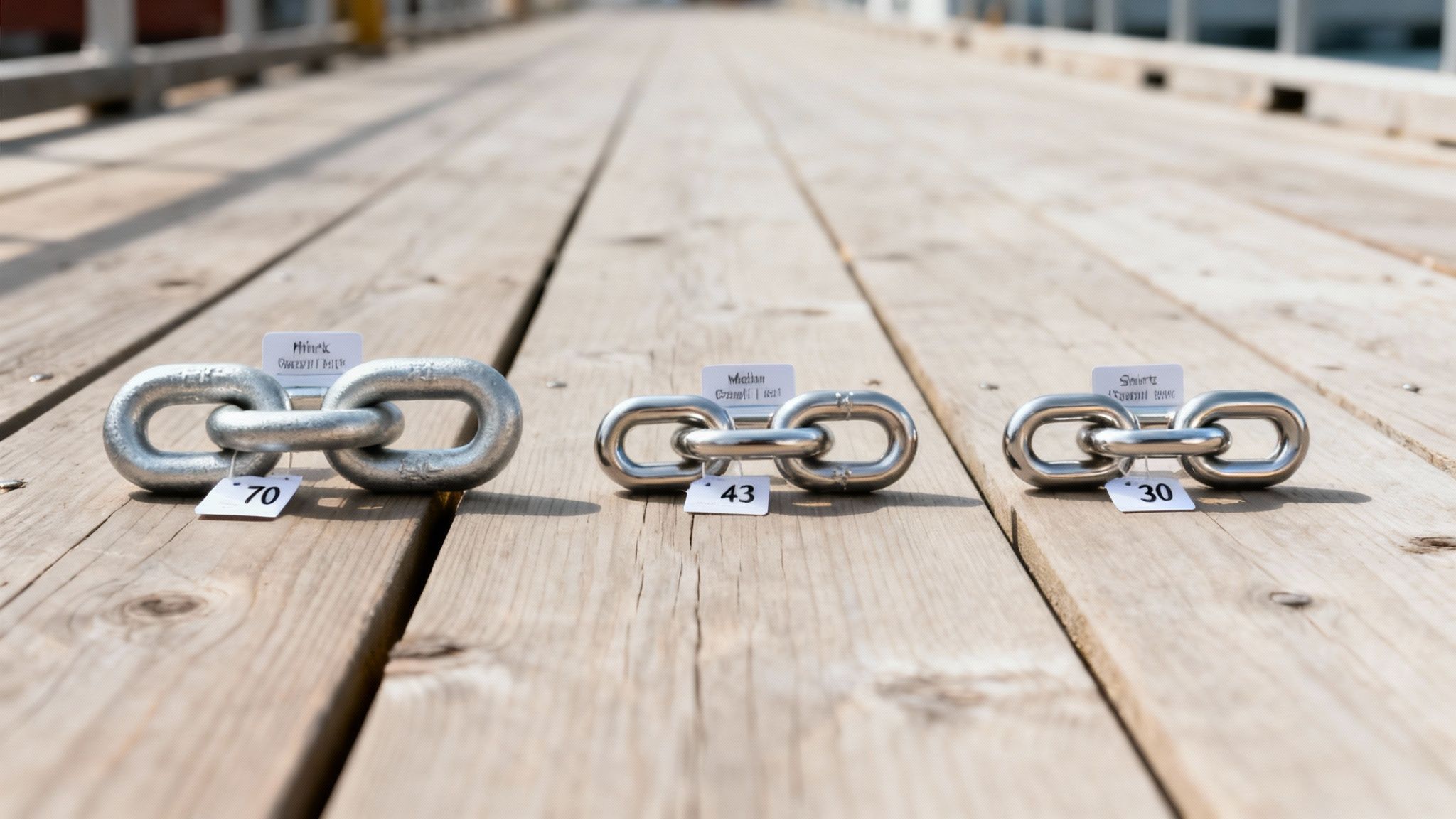
It’s easy to think all anchor chains are pretty much the same. They're just a bunch of metal links, right? Not quite. The chain you trust to keep your boat safe hides a surprising amount of engineering, broken down into different grades and materials that directly impact its strength, weight, and lifespan.
Picking the right one is crucial. Using the wrong chain is like trying to stop a truck with a rope meant for a canoe—it’s just not going to end well. Getting a handle on these differences is the first real step to building an anchoring system you can truly rely on.
Chain grades are really just a simple way of talking about strength. Every grade has a Working Load Limit (WLL), which is the maximum force it's designed to handle day in and day out. This number is usually only about 25% of the chain's ultimate breaking strength, giving you a very healthy safety margin.
The Most Common Chain Grades
For most of us out on the water, there are three grades you'll run into. They’re all made from carbon steel, but they get their unique muscle from different heat-treatment processes.
- Grade 30 (G30 or Proof Coil): Think of G30 as the trusty workhorse. It’s the most common and most affordable option you'll find. For plenty of small to mid-sized boats in typical conditions, it’s a perfectly solid choice that gets the job done without breaking the bank.
- Grade 43 (G43 or High Test): This is where things get serious. High Test chain is a huge step up, boasting about 50% more strength than G30 of the same link size. The big win here? You can often use a smaller, lighter chain without giving up an ounce of strength, which is fantastic for reducing weight in the bow.
- Grade 70 (G70 or Transport Chain): You'll often spot this chain by its distinct gold chromate finish. While G70 is incredibly strong, it’s honestly overkill for most recreational boats. It’s more at home in the industrial world, lashing heavy equipment to flatbed trucks.
These standards are what keep the marine industry safe. The market for gear like Stud Link Anchor Chains, valued at around USD 1.14 billion back in 2019, depends on rigorous testing to make sure this stuff works when it absolutely has to. If you’re curious, you can explore more about the marine anchor chain market to see how quality standards shape the industry.
Link Shape: A Perfect Fit for Your Windlass
Strength isn't the only thing that matters. The actual physical shape of the chain links is incredibly important, especially if you have a windlass. That notched wheel on your windlass, called a gypsy, is machined with precision to grab a very specific chain link shape and size.
Get this wrong, and you're asking for trouble. A mismatched chain will jam, slip, and can do serious damage to your expensive windlass.
Key Takeaway: Always, always match your boat anchor chain to your windlass gypsy's specifications. The grade, link size, and shape must be compatible for the system to work safely.
You'll generally encounter two common link patterns:
- BBB (Triple B): This chain is made with short, stout links and is almost always Grade 30. It’s designed specifically for windlass gypsies that call for the BBB pattern.
- HT (High Test): This is the link pattern you'll find on Grade 43 chains. The links are a bit longer and narrower than their BBB counterparts.
And no, you can't mix and match. A G43 HT chain will absolutely not work on a gypsy designed for G30 BBB chain, or the other way around. They just won't fit.
Galvanized Steel vs. Stainless Steel
The last piece of the puzzle is the material itself and how it's protected from the harsh saltwater environment.
Hot-Dip Galvanized Steel: This is, by far, the most popular choice for anchor chain, and for good reason. The steel chain is literally dipped in a vat of molten zinc, which creates a thick, tough coating that fights off corrosion like a champ. It's rugged and cost-effective, though that zinc coating will eventually wear down over many years of use and may need to be re-galvanized.
Stainless Steel: It’s impossible to deny that stainless steel chain looks fantastic. It’s incredibly rust-resistant and keeps that polished shine without any coating. But that beauty comes with a much bigger price tag. It can also, under some very specific low-oxygen conditions (like being buried deep in muck for a long time), fall victim to something called crevice corrosion.
For the vast majority of boaters, a high-quality galvanized chain delivers the best all-around mix of performance, durability, and value.
Selecting the Right Chain Diameter and Length
Figuring out the right size for your boat's anchor chain isn’t something you want to guess at—it's honestly one of the most critical decisions you'll make for your entire anchoring setup. Go too light, and the chain won't have the muscle to hold your boat when the wind kicks up. On the flip side, a chain that's too heavy is just dead weight on the bow, which can mess with your boat's handling and performance.
The trick is finding that sweet spot between bulletproof security and everyday performance. Get it right, and your anchor will dig in and hold, your windlass will run smoothly, and you'll sleep a lot better at night, no matter where you drop the hook.
How to Choose the Right Chain Diameter
The diameter of your anchor chain is all about strength and weight. The big things you need to think about are your boat's overall length, its displacement (how much it weighs all loaded up), and its windage—basically, how much it acts like a sail in the wind. A high-sided powerboat, for instance, gets pushed around a lot more than a sleek sailboat of the same length.
A great starting point is to use your boat's length to get a ballpark diameter. Just remember, stronger chains like G43 let you use a smaller diameter than a standard G30 chain while giving you the same (or even better) strength. This is a fantastic way to cut down on weight in the bow without sacrificing safety.
Expert Tip: When in doubt, always size up. The extra peace of mind that comes from a slightly beefier anchor chain is absolutely worth the tiny bit of extra weight and cost.
Here's a handy reference to get you started on picking the right chain diameter for your boat.
Recommended Anchor Chain Diameter by Boat Length
This table gives you a quick look at common chain sizes based on boat length. It’s a solid starting point, but always double-check it against your boat manufacturer's recommendations.
| Boat Length (ft) | Recommended G30/BBB Diameter (in) | Recommended G43/HT Diameter (in) |
|---|---|---|
| Up to 25' | 1/4" | 1/4" |
| 26' - 35' | 5/16" | 1/4" |
| 36' - 45' | 3/8" | 5/16" |
| 46' - 55' | 1/2" | 3/8" |
| 56' - 65' | 5/8" | 1/2" |
Before you buy, make sure to cross-reference these suggestions with your boat's manual and, just as importantly, the specs for your windlass.
Determining the Ideal Chain Length
Once you've nailed down the diameter, the next big question is: how much do you need? The right length really comes down to where you do most of your anchoring. An all-chain rode has a huge advantage here—its own weight helps keep the pull on the anchor low and horizontal, meaning you can often use less scope than you would with a rope-and-chain combo. That's a game-changer in a tight, crowded anchorage.
The old-school "rules of thumb" for scope (the ratio of rode length to depth) can sometimes be a bit misleading. A 4:1 scope might not be nearly enough in shallow water, while a 7:1 scope can feel like overkill in deeper spots.
A much better approach for an all-chain rode is to use a formula that gives you a solid base length plus a bit more for every foot of depth. This ensures you always have enough chain out to create that all-important "catenary curve" that lets your anchor do its job.
For an all-chain setup, a trusted formula is:
Chain Length = 50 feet + (2 x Depth)
Let's see how that plays out in the real world:
- Anchoring in 20 feet of water: 50 + (2 x 20) = 90 feet of chain.
- Anchoring in 40 feet of water: 50 + (2 x 40) = 130 feet of chain.
This method gives you a safe minimum, but don't be afraid to let out more chain if the weather is turning nasty or if you’re leaving the boat for a while. To really get into the weeds and fine-tune your setup, check out our complete guide on how much anchor chain you really need. It’ll help you dial in the perfect length for maximum security.
Creating a Secure Rope to Chain Connection
For a lot of boaters, a mix of rope and chain—what we call a combination rode—is the perfect setup. You get the tough, abrasion-resistant boat anchor chain doing the hard work near the anchor, plus the lightweight, shock-absorbing benefits of a good nylon line. But this whole system is only as strong as its weakest link, which is often where the rope and chain meet.
Nailing this connection is critical. It needs to be strong enough to handle a nasty squall but also smooth enough to run through your windlass without jamming up. A sloppy connection is a huge liability and undermines your entire anchoring setup. Get it right, and you'll sleep a whole lot better at anchor.
There are two classic, time-tested ways to join rope to chain. Your choice really comes down to your gear and how comfortable you are with a little bit of rope work.
The Rope to Chain Splice Method
Most experienced sailors will tell you that a direct rope-to-chain splice is the gold standard. It's the strongest and most reliable way to connect your nylon rope right to the last link of the chain.
When you do it properly, the splice creates a smooth, tapered connection that glides effortlessly over the bow roller and through a windlass gypsy. No more frustrating jams when you're trying to weigh anchor.
Splicing can look a bit intimidating at first, but it's a skill any serious boater can pick up. The idea is to unlay the rope's strands and weave them back into themselves through that final chain link. This creates a bond that can actually be stronger than the rope itself. The secret is keeping your tucks tight and even to spread the load perfectly.
This visual guide shows the fundamental process of selecting the right anchor chain for your boat, from considering your vessel's size to choosing the anchor.
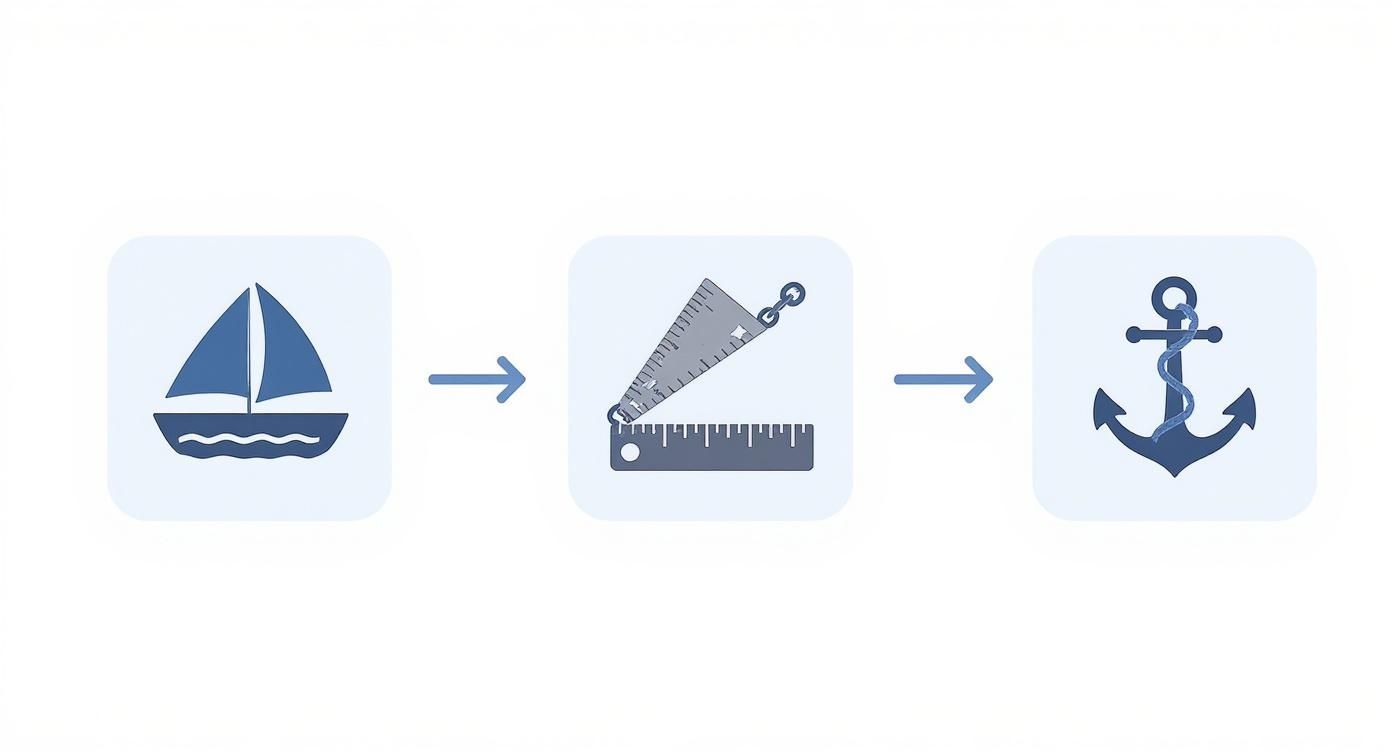
The flow from boat to anchor highlights that every decision in your anchoring system is interconnected, and the chain is a central piece of that puzzle.
If you're new to splicing, practice makes perfect. You can get a better feel for handling different types of line by checking out our guide on choosing the right anchor rope, which dives into the materials and construction that make a rope good for splicing.
The Thimble and Shackle Method
If splicing isn’t your thing, don't worry. Using a thimble and shackle is a rock-solid and much simpler alternative. This method is easier to put together and, just as importantly, easier to inspect for wear and tear, which is why it's so popular.
Here’s the breakdown:
- Create an Eye Splice: First, you splice a permanent loop, called an eye splice, into the end of your rope.
- Insert a Thimble: You then fit a stainless steel or galvanized thimble inside that loop. This grooved metal shield is crucial—it protects the rope fibers from being chafed and cut by the hard metal of the shackle.
- Connect with a Shackle: Finally, you connect the thimbled eye to the last link of your boat anchor chain with a properly sized anchor shackle.
Crucial Safety Step: Always seize the shackle pin. Once you’ve tightened the pin down, wrap it securely to the body of the shackle with stainless steel seizing wire. This simple step is non-negotiable; it stops the pin from vibrating loose over time, which is a surprisingly common cause of anchoring failure.
Essential Chain Inspection and Maintenance
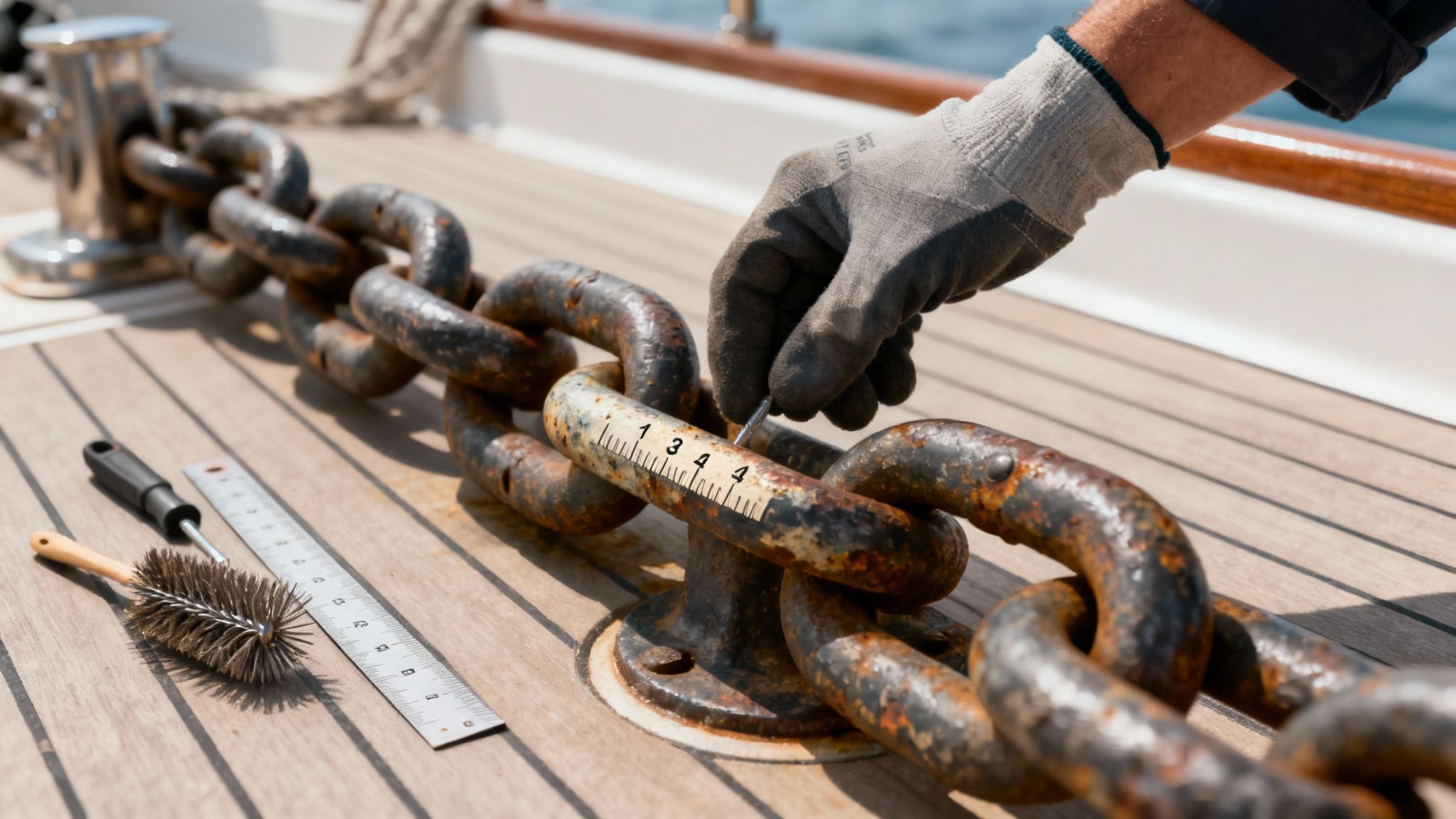
Your boat anchor chain is in a constant battle with the elements. It’s dragged through abrasive sand and mud, scraped across rocks, and dunked in corrosive saltwater day in and day out. Just like any other critical piece of safety gear on your vessel, it needs regular attention to make sure it’s ready to perform when you need it most.
This isn’t just about making your gear last longer; it's about making sure your boat stays put. A failing chain is a serious liability, and the key to anchoring with confidence is catching problems before they start. A quick visual check every few months and a more thorough inspection at the end of the season can make all the difference.
What to Look For During Inspection
When you inspect your anchor chain, you’re basically a detective looking for clues of wear and tear. The best way to do this is to lay the entire length of the chain out on a dock or driveway. You need to see every single link.
Here’s your quick inspection checklist:
- Rust and Galvanizing Wear: Look for spots where the protective zinc coating has worn away, exposing the raw steel underneath. A little surface rust isn’t a deal-breaker, but deep, pitting corrosion is a huge red flag—it means the link is getting weaker.
- Bent or Deformed Links: Go through link by link and check for any signs of bending, twisting, or stretching. A deformed link is a compromised link, plain and simple. It's lost a serious amount of its original strength.
- Worn Contact Points: Pay close attention to where the links rub against each other. Over time, this constant friction grinds down the metal, making the link thinner. If you see that a link has lost more than 10-15% of its original thickness, it’s time to start thinking about a replacement.
This need for durability is why the marine industry is always pushing for stronger materials. The global boat anchor chain market is projected to hit about USD 2.1 billion by 2025, with a lot of that growth coming from new corrosion-resistant coatings and high-strength alloys. Discover more insights about the boat anchor chain market to see how tech is making anchoring safer.
End-of-Season Cleaning and Care
Giving your chain a solid cleaning at the end of the season is one of the best things you can do for it. This simple task gets rid of all the salt, mud, and gunk that can accelerate corrosion while your boat is stored for the winter.
It’s pretty straightforward. Just lay the chain out and give it a thorough rinse with fresh water. For stubborn grime, a good boat soap and a stiff brush will do the trick, cutting through the mess without any harsh chemicals. This is a vital step in caring for your entire setup; check out our comprehensive guide to your boat anchor system to see how all the pieces work together.
Once it's clean, let the chain dry completely before you stow it. Piling a wet chain into the anchor locker is the perfect recipe for rust and mildew. A little prevention here goes a very long way.
Re-Galvanizing vs. Replacement
So, what do you do if your chain's protective zinc coating is mostly gone but the links themselves are still in good shape? Re-galvanizing can be a great, cost-effective option. The process involves stripping off the old coating and rust, then dipping the chain in molten zinc for a fresh, thick layer of protection.
But it’s not always the best answer. If your inspection turns up multiple bent links, significant wear, or deep rust pits, replacement is the only safe choice. A new coat of zinc can't magically fix structurally weakened steel.
Marking Your Chain for Easy Scope Management
Knowing how much rode you have out is absolutely essential for anchoring correctly. Marking your chain at regular intervals takes all the guesswork out of deploying the right amount of scope for the depth.
- Colored Zip Ties: This is the most popular method by far. Use different colored zip ties to mark intervals, like every 25 or 50 feet.
- Chain Marking Paint: You can also get special marine-grade paint to apply directly to the links. You can create a color-coded system or just paint a specific number of links to indicate the length.
Common Anchor Chain Mistakes to Avoid
Even the strongest, most expensive boat anchor chain is useless if it’s part of a flawed system. I’ve seen it happen time and again: simple oversights and common mistakes can completely undermine your anchoring security, turning what should be a peaceful night into a stressful, drifting ordeal. Think of this as your final safety check, reinforcing the practices that separate a secure hold from a potential disaster.
Avoiding these common pitfalls is pretty straightforward, but it demands a bit of know-how and attention to detail. Getting these fundamentals right ensures every single piece of your ground tackle works together like it’s supposed to—as one solid, reliable unit.
Mismatching Your Chain and Windlass Gypsy
One of the most frequent—and damaging—errors is using a chain that doesn't perfectly match the windlass gypsy. The gypsy is that notched wheel on your windlass that grabs and pulls the chain links. It’s not a one-size-fits-all part; it’s precision-engineered for a specific chain size (like 5/16") and a specific link type (like BBB or G43 HT).
Using the wrong chain is a recipe for failure. The links will either jump and slip under load, or they'll jam up tight, potentially burning out your windlass motor or causing serious mechanical damage. This isn't a "close enough" situation. It has to be an exact match.
Safety Alert: Always, always verify your windlass manufacturer's specifications before buying a new boat anchor chain. An incompatible chain isn't just an inconvenience; it's a critical failure point that can leave you unable to raise or lower your anchor when you need it most.
Neglecting to Use a Snubber or Bridle
Letting your all-chain rode pull directly on the windlass and bow roller puts an incredible amount of stress on your hardware. Every wave and gust of wind sends a jarring shock load right through the whole system. You'll hear it, you'll feel it, and it's accelerating the wear and tear on your gear. This is exactly why an anchor snubber or bridle is so important.
This simple tool is just a length of stretchy nylon rope with a chain hook. It attaches to your chain and transfers the anchoring load from your windlass to a sturdy cleat. That bit of nylon stretch absorbs the shocks, quieting the ride at anchor, and protecting your expensive equipment from those punishing forces.
Using Undersized or Unsecured Shackles
The shackle connecting your anchor to the chain is a critical link, yet it's so often overlooked. Using a shackle that’s a size smaller than your chain creates an immediate weak point right where you can't afford one. The rule is simple: the shackle must always have a Working Load Limit (WLL) equal to or greater than the chain itself.
Even more critical is making sure the shackle pin is secured. The constant motion and vibration at anchor can cause an unsecured pin to slowly work itself loose over time. Always seize the pin by wrapping it tightly to the shackle's body with stainless steel seizing wire. It's a five-minute task that prevents a complete and catastrophic failure.
Boat Anchor Chain FAQs
Even after you've got a handle on grades, sizes, and proper care, a few specific questions always seem to pop up. Let's tackle some of the most common things boaters ask about their boat anchor chain so you can drop anchor with total confidence.
How Often Should I Replace My Anchor Chain?
There’s no hard-and-fast expiration date for anchor chain. How long it lasts really boils down to how often you anchor, the kind of water you're in, and how well you take care of it. The best practice is to give it a thorough end-to-end inspection at least once a year.
What are you looking for? Keep an eye out for deep rust pits or any links that look visibly worn down. If you notice a link has lost more than 10-15% of its original diameter, that's a major red flag. Same goes for any bent or deformed links. When large patches of the galvanizing have worn off and serious rust is setting in, you have two choices: get it re-galvanized or replace it entirely. With good care, a quality chain can easily serve you for a decade or more.
Can I Connect Different Chain Sizes or Grades?
We get this question a lot, and the short answer is: please don't. It's a bad idea for a couple of key reasons. Remember, a chain is only as strong as its weakest link. If you shackle a high-strength G43 chain to a standard G30, the entire system is only as strong as that G30 section. You've just paid for strength you can't actually use.
Mixing different sizes is an even bigger headache. Your windlass gypsy is precision-machined for one specific chain size. A mismatched link will jam, skip, and potentially damage the windlass, which is the last thing you want to deal with in a crowded anchorage. For your safety and the health of your gear, always stick with a single, continuous length of the right size and grade for your boat.
What Is an Anchor Snubber and Do I Need One?
Absolutely. If you have an all-chain rode, an anchor snubber isn't just a nice-to-have accessory; it's essential gear. It’s simply a length of sturdy nylon rope with a chain hook on one end. You attach the hook to your anchor chain a short distance from the bow and run the other end of the rope to a strong deck cleat. This takes the load off your windlass.
The snubber’s most important job is to act as a shock absorber. Nylon rope has a natural stretch to it, which cushions the boat from the jarring tugs of waves and wind. This dramatically reduces the strain on your boat's hardware, quiets things down on deck, and makes for a much more comfortable and peaceful night at anchor. It’s a small piece of gear that makes a huge difference.
At Better Boat, we know that a secure anchoring system is the foundation of safe boating. From the right chain to the strongest lines and cleaning supplies that protect your investment, we offer everything you need to keep your vessel in top shape. Explore our complete collection of premium boating accessories at https://www.betterboat.com and anchor with total peace of mind.




